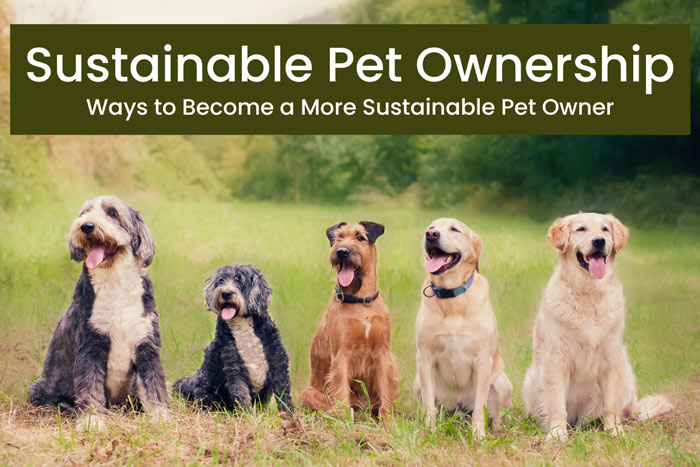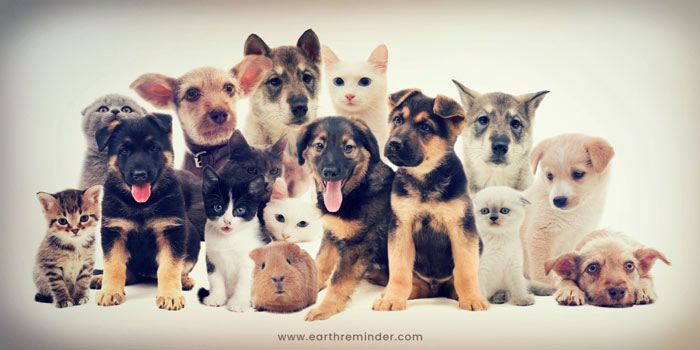Sustainable Pet Ownership: Ways to Become a Sustainable Pet Owner
As we collectively become more aware of the impact of our environmental footprint, we’ve learned to incorporate more responsible consumption practices into our daily lives. From using renewable energy to power our homes to carrying our groceries in reusable grocery bags, we’ve found many ways to reduce our waste and conserve the world’s resources as best we can. Many individuals around the world have even gone as far as making sustainability and environmental friendliness a core part of their lifestyles, extending these concepts to their roles as pet owners.
If it’s your goal to become a more sustainable pet owner yourself, know that it encompasses more than merely caring for your pet in a responsible manner. It also involves making conscious choices to diminish the environmental implications of pet-related activities like buying pet products and managing your pet’s waste. But in truth, there’s more to it than simply shrinking your environmental footprint. You also have to take your pet’s well being into account and ensure that you can live sustainably without compromising on the care and love that your pet needs.
Fortunately, now that there’s a bigger community of environmentally-conscious pet owners and now that more pet brands have begun baking sustainability into their business models, it’s not as hard to practice sustainable and responsible pet ownership. Here are a few examples of how you can incorporate sustainability into your pet care routine:
Table of Contents
Familiarize Yourself with The Responsibilities of a Sustainable Pet Owner
If you’re diving into the world of sustainable pet ownership for the very first time, the first thing you should do is educate yourself on a sustainable lifestyle and how exactly this translates into your role as a pet parent. Among the first lessons you’ll learn are the following:
-
- It’s better to opt for eco-friendly pet toys. When buying toys for your pet, look for varieties that are pet-safe and made from recycled or sustainably sourced materials. Look up the manufacturing information of a pet toy before making a purchase and choose items that utilize eco-friendly materials like natural rubber, recycled plastics, and hemp fabric.
- Pay attention to how your pet products are packaged. Support companies that sell products made with minimal or recycled packaging to reduce overall waste. Choosing to buy pet food in bulk over individually packaged portions will also lower your waste generation.
- Promote neutering/spaying as a practice. Controlling the pet population by spaying or neutering helps reduce the strain on animal shelters and decreases the number of homeless animals in your community. These procedures also prevent unplanned litters and will mitigate issues caused by overpopulation. Support spaying and neutering as part of your journey towards more sustainable pet ownership, and also take a stand against unethical practices like kitten or puppy farming.
Make The Informed Choice When Buying Sustainable Pet Products
Investing in sustainable pet products typically means buying items made from environmentally friendly materials. The move towards high-quality and eco-friendly pet products will play a significant role in your journey towards becoming a more responsible pet owner, as these items will provide you and your pet with more value and reduce your contributions to the waste stream.
When looking for high-quality and sustainable products, be on the lookout for the following indicators.
- Higher-quality products, despite sometimes having a higher upfront cost, are often more durable than their cheaper counterparts. As such, investing in high-quality dog collars, cat scratching posts, and even pet enclosures will ensure that your pet will get to use and enjoy these products for years. Choosing more durable pet items of topnotch quality also eliminates the need to buy new products more often. This, in turn, will reduce waste and save you money over time.
- Minimal use of packaging. Quality products often come with less flashy packaging. This approach typically highlights a product’s quality rather than its wrapping and results in less waste generation. Again, consider throwing your support behind pet product manufacturers that use innovative and minimally wasteful packaging on their items.
- Use of sustainable materials. Many high-quality pet products like toys, collars, leashes, and harnesses use sustainably sourced materials or those made from recycled goods. Products like these show that the manufacturer values environmental responsibility, and supporting them will reduce your pet’s carbon pawprint.
Use Sustainable Pet Care Methods
Sustainable pet care also boils down to embracing the three Rs – reduce, reuse, and recycle – in your pet’s everyday life. Here are some practical methods for applying this philosophy:
- DIY your pet toys. Instead of always buying new toys for your pet, consider repurposing household items that will make excellent alternatives. An old tennis ball or a sock can be transformed into a playful chew toy for your dog, while unused cardboard boxes can be used to build cat playhouses or be cut and transformed into cat scratching surfaces.
- Consider making homemade pet food and treats. Though many companies have begun producing pet food from responsibly sourced ingredients, you can also shrink your pet’s environmental pawprint by making your own pet food at home. Homemade pet food gives you more control over what goes into your pet’s diet, making the meals healthier for your furry friend and minimizing the resources you consume to feed them. What’s more, you can source your pet food ingredients wisely and give yourself more room to make more sustainable purchasing choices for your household.
- Be wise about waste management. Biodegradable waste bags are becoming more common and are a great way to manage your pet’s waste sustainably. Alternatively, if local guidelines permit you to do so, you can compost your pet waste for an eco-friendly solution for disposal.
Support Eco-Friendly Pet Brands
Supporting eco-friendly pet brands is an effective way to reduce your environmental footprint and encourage sustainable practices within the industry. By choosing these brands, you’ll set a good precedent for other pet owners and help push the demand for sustainable business practices in the pet product market. Here’s how you can identify and support these brands:
- Look for transparency. Genuinely eco-friendly pet brands are usually transparent about their sustainability efforts. They’ll provide you with information about their sourcing, manufacturing, and packaging processes. Reading through this information will help you gather insight into their commitment to environmental preservation.
- Check for certifications. Several independent bodies certify brands based on their eco-friendly practices. These certifications—such as cruelty-free, organic, or fair-trade labels—lend credibility to a brand’s claims of sustainability. Brands sporting these certifications generally adopt responsible practices throughout their supply chain.
- Choose local. Choosing local pet brands often means a smaller carbon footprint and pawprint due to reduced transportation and distribution needs. Moreover, local brands tend to be more in tune with their communities and are likelier to engage in local sustainability initiatives. By supporting them, you’ll help bolster your local economy and contribute to regional environmental efforts.
Transitioning towards sustainable pet ownership is a gradual process—one that starts with small, but conscious decisions. All the same, even the smallest steps will bring you closer to a holistically sustainable lifestyle.
As a pet owner, you have an opportunity to lead by example and influence the pet product market in a greener and more positive direction. By considering sustainability in your choices as a pet parent, you can strike a balance between providing the best for your pet and contributing to our planet’s well-being.

